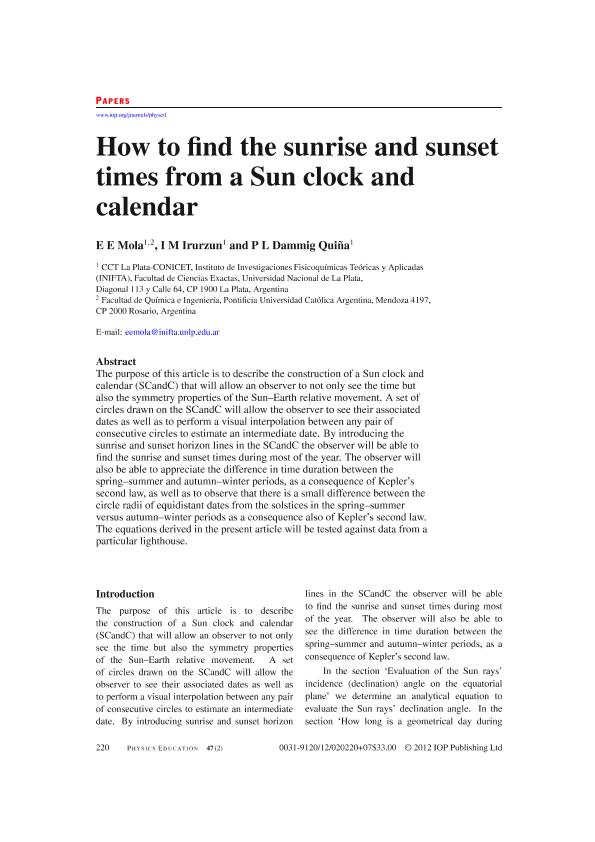Mostrar el registro sencillo del ítem
dc.contributor.author
Mola, Eduardo Elías

dc.contributor.author
Irurzun, Isabel Maria

dc.contributor.author
Dammig Quiña, Pablo Leandro

dc.date.available
2019-09-25T14:00:40Z
dc.date.issued
2012-03
dc.identifier.citation
Mola, Eduardo Elías; Irurzun, Isabel Maria; Dammig Quiña, Pablo Leandro; How to find the sunrise and sunset times from a Sun clock and calendar; IOP Publishing Ltd; Physics Education; 47; 2; 3-2012; 220-226
dc.identifier.issn
0031-9120
dc.identifier.uri
http://hdl.handle.net/11336/84385
dc.description.abstract
The purpose of this article is to describe the construction of a Sun Clock and Calendar (SCandC) that will allow an Observer of it not only to know the time but also the simmetry properties of the Sun-Earth relative movement. A set of circles drawn on the SCandC will allow the Observer to know their associated dates as well as to perform a visual interpolation between any pair of consecutive circles to estimate an intermediate date. By introducing the Sunrise and Sunset Horizon Lines in the SCandC the Observer will be able to know the Sunrise and Sunset times during most of the year. The Observer will also be able to appreciate the difference in time duration between the Spring -Summer and Autumn - Winter periods, as a consequence of Kepler´s Second Law as well as to observe that there is a small difference between the circle radius of equidistant dates from the solstices in the Spring- Summer vs Autumn-Winter periods as a consequence also of Kepler´s Second Law The equations derived in the present article will be tested against data from a particular Lighthouse.
dc.format
application/pdf
dc.language.iso
eng
dc.publisher
IOP Publishing Ltd
dc.rights
info:eu-repo/semantics/openAccess
dc.rights.uri
https://creativecommons.org/licenses/by-nc-sa/2.5/ar/
dc.subject
Sun Clock
dc.subject
Sun-Earth Relative Movement
dc.subject
Sunrise
dc.subject
Sunset
dc.subject.classification
Astronomía

dc.subject.classification
Ciencias Físicas

dc.subject.classification
CIENCIAS NATURALES Y EXACTAS

dc.subject.classification
Matemática Aplicada

dc.subject.classification
Matemáticas

dc.subject.classification
CIENCIAS NATURALES Y EXACTAS

dc.title
How to find the sunrise and sunset times from a Sun clock and calendar
dc.type
info:eu-repo/semantics/article
dc.type
info:ar-repo/semantics/artículo
dc.type
info:eu-repo/semantics/publishedVersion
dc.date.updated
2019-05-06T14:42:09Z
dc.journal.volume
47
dc.journal.number
2
dc.journal.pagination
220-226
dc.journal.pais
Reino Unido

dc.description.fil
Fil: Mola, Eduardo Elías. Consejo Nacional de Investigaciones Científicas y Técnicas. Centro Científico Tecnológico Conicet - La Plata. Instituto de Investigaciones Fisicoquímicas Teóricas y Aplicadas. Universidad Nacional de La Plata. Facultad de Ciencias Exactas. Instituto de Investigaciones Fisicoquímicas Teóricas y Aplicadas; Argentina
dc.description.fil
Fil: Irurzun, Isabel Maria. Consejo Nacional de Investigaciones Científicas y Técnicas. Centro Científico Tecnológico Conicet - La Plata. Instituto de Investigaciones Fisicoquímicas Teóricas y Aplicadas. Universidad Nacional de La Plata. Facultad de Ciencias Exactas. Instituto de Investigaciones Fisicoquímicas Teóricas y Aplicadas; Argentina
dc.description.fil
Fil: Dammig Quiña, Pablo Leandro. Consejo Nacional de Investigaciones Científicas y Técnicas. Centro Científico Tecnológico Conicet - La Plata. Instituto de Investigaciones Fisicoquímicas Teóricas y Aplicadas. Universidad Nacional de La Plata. Facultad de Ciencias Exactas. Instituto de Investigaciones Fisicoquímicas Teóricas y Aplicadas; Argentina
dc.journal.title
Physics Education
dc.relation.alternativeid
info:eu-repo/semantics/altIdentifier/doi/http://dx.doi.org/10.1088/0031-9120/47/2/220
dc.relation.alternativeid
info:eu-repo/semantics/altIdentifier/url/https://iopscience.iop.org/article/10.1088/0031-9120/47/2/220
Archivos asociados
